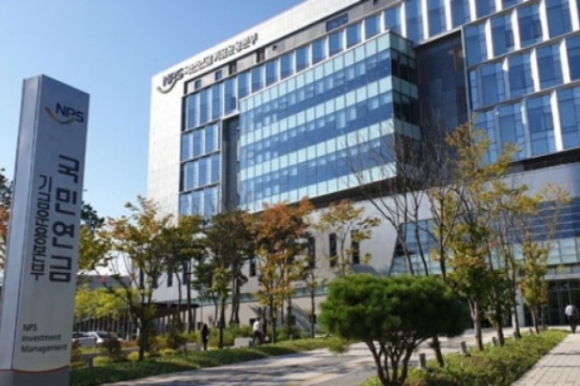Pension funds
NPS to slash Korean asset proportion, increase overseas stocks
The pension fund set a five-year plan to prepare for the super-aging era; total assets are set to decline from 2039
By May 27, 2022 (Gmt+09:00)
3
Min read
Most Read
LG Chem to sell water filter business to Glenwood PE for $692 million


Kyobo Life poised to buy Japan’s SBI Group-owned savings bank


KT&G eyes overseas M&A after rejecting activist fund's offer


StockX in merger talks with Naver’s online reseller Kream


Mirae Asset to be named Korea Post’s core real estate fund operator



National Pension Service (NPS) of South Korea, the world’s third-largest pension fund, has adjusted its five-year asset allocation plan to enhance investment return as well as minimize its impact on the local stock market. It is planning to reduce exposure to Korean public equity and bonds while increasing overseas assets.
NPS fund management committee decided to reduce its domestic public equity proportion to 14% by end-2027, during its annual mid-to-long-term investment meeting on Friday. Last year, the committee set the proportion as 14.5% by end-2026.
The local equity proportion is set to be 16.3% by the end of this year. Despite the reduction in the percentage, the pension fund’s Korean equity investment volume will increase from 164.9 trillion won ($131.6 billion) at end-2022 to 192 trillion won at end-2027 due to the soaring assets under management.
NPS also decided to slash the domestic public bond proportion to 22.9% as of the end-2027 from 34.5% as of end-2022. Last year, the pension fund set the local bond proportion as 24.7% by end-2026. Due to the drastic reduction in the percentage, the local bond investment size will decline from 348.1 trillion won as of end-2022 to 347.1 trillion won by end-2023 and 314.1 trillion won by end-2027.
On the other hand, overseas assets are set to increase. Investing 26.2% of the AUM in overseas public bonds as of the end-February, the pension fund set the amount at 38.5% by end-2026. During the Friday meeting, it increased the percentage to 40.3% as of end-2027.
The pension plan held the overseas public bond proportion at 8% for both end-2026 and end-2027. The target exposure in alternative investment slightly rose from 14.3% as of end-2026 to 14.8% as of end-2027.
RAPID AGING PRESSURES LIQUIDATION PLAN
There are two main reasons for NPS’ move to reduce exposure to Korean equity while increasing global equity.
The first reason is that overseas assets show greater profitability than local assets. The pension fund saw a 6.45% annualized return on local assets for the past three years, compared with 18.04% on overseas assets during the same period. The gap between the returns further widened last year with the start of the economic recovery – 2.04% return on local assets and 25.44% on overseas assets.
“Overseas assets’ return rate has been more than double or triple local assets’ return rate in the past. Based on the high profitability and diversification effects, the fund management arm should increase overseas investment,” the committee said on Friday.
The other reason is to minimize shock to the local stock market by disinvesting in the future. The number of pension recipients is growing fast in Korea due to the soaring aging population, which increases the need for reserve funds and thus disinvesting. If NPS continues to hold a high proportion of Korean stocks, its share dumping all at once could severely impact the local stock market.
LARGER SHOCK TO KOREAN BOND MARKET
NPS accounts for 6.3% of the market capitalization on the main bourse Kospi and secondary Kosdaq combined as of end-2021. It will continue to gradually reduce exposure to domestic equity and bonds in a bid to prevent the liquidation-caused impact on the local market, the committee said.
The pension fund’s total assets reached 918.2 trillion won as of end-February. The assets will steadily increase to 1.07 quadrillion won until 2038 and will decline from 2039, according to Korea’s National Assembly Budget Office’s estimates in 2020. This indicates NPS has 17 years to distribute pension funds by liquidating assets.
NPS won’t shock the Korean stock market in the short term as the increase in its assets will overwhelm the decrease in ownership percentage. However, its influence on the local public bond market will be larger as the overall investment size will decline.
Write to Eui-Jin Jeong and Jun-Ho Cha at justjin@hankyung.com
Jihyun Kim edited this article.
More to Read
-
 Pension fundsNPS, KTCU to invest $390 mn in US major power generator
Pension fundsNPS, KTCU to invest $390 mn in US major power generatorMay 19, 2022 (Gmt+09:00)
2 Min read -

-
 Pension fundsNPS’ shareholder meeting vetoes cast pall on its profitability
Pension fundsNPS’ shareholder meeting vetoes cast pall on its profitabilityApr 20, 2022 (Gmt+09:00)
2 Min read -
 Pension fundsNPS hires Millennium, Starboard, Systematica for hedge fund investing
Pension fundsNPS hires Millennium, Starboard, Systematica for hedge fund investingFeb 28, 2022 (Gmt+09:00)
1 Min read -
 Pension fundsAdams Street, Benefit Street, Clearlake join NPS' PE managers
Pension fundsAdams Street, Benefit Street, Clearlake join NPS' PE managersFeb 28, 2022 (Gmt+09:00)
2 Min read
Comment 0
LOG IN


